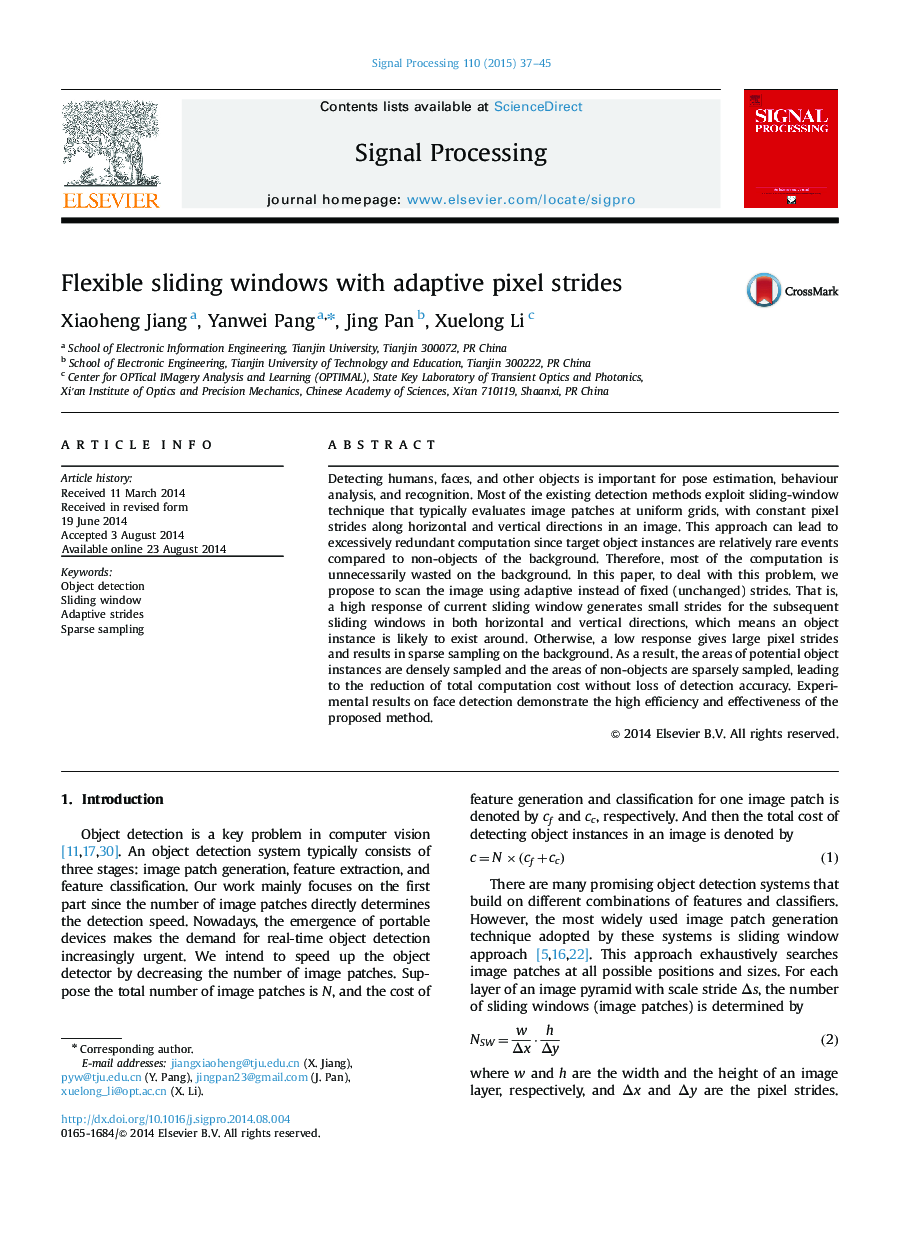| کد مقاله | کد نشریه | سال انتشار | مقاله انگلیسی | نسخه تمام متن |
|---|---|---|---|---|
| 6959305 | 1451957 | 2015 | 9 صفحه PDF | دانلود رایگان |
عنوان انگلیسی مقاله ISI
Flexible sliding windows with adaptive pixel strides
ترجمه فارسی عنوان
پنجره های کشویی قابل انعطاف با گام های پیکسل تطبیقی
دانلود مقاله + سفارش ترجمه
دانلود مقاله ISI انگلیسی
رایگان برای ایرانیان
کلمات کلیدی
تشخیص شی، پنجره کشویی، گام های سازگار، نمونه برداری انعطاف پذیر،
ترجمه چکیده
تشخیص انسان ها، چهره ها و اشیاء دیگر برای برآورد پوسته، تجزیه و تحلیل رفتار و شناخت مهم است. اکثر روش های تشخیص موجود، از تکنیک کشویی پنجره استفاده می کنند که معمولا تکه های تصویر را در شبکه های یکنواخت ارزیابی می کند، با گام های ثابت پیکسل در جهت افقی و عمودی در یک تصویر. این رویکرد می تواند به محاسبات بیش از حد بیش از حد منجر شود، زیرا نمونه های هدف شیء نسبتا نادرست در مقایسه با غیر از پس زمینه است. بنابراین، اکثر محاسبات بی فایده بر روی پس زمینه هدر رفته است. در این مقاله، برای مقابله با این مشکل، پیشنهاد می کنیم تصویر را با استفاده از تطبیقی به جای گام های ثابت (بدون تغییر) اسکن کنیم. به این معنی که پاسخ بالا پنجره کشویی فعلی، گام های کوچکی برای پنجره های کشویی بعدی در هر دو جهت افقی و عمودی ایجاد می کند، به این معنی است که نمونه احتمالا در اطراف وجود دارد. در غیر این صورت، یک پاسخ کم، گام های بزرگ پیکسل را فراهم می کند و نتایج نمونه گیری را در پس زمینه به دست می دهد. در نتیجه، مناطقی از نمونه های بالقوه نمونه به صورت نمونه ای جمع آوری می شوند و مناطق غیر اشیائی کمترین نمونه را انتخاب می کنند که منجر به کاهش کل هزینه محاسبات بدون از دست دادن دقت تشخیص می شود. نتایج تجربی در تشخیص چهره نشان دهنده راندمان بالا و کارایی روش پیشنهادی است.
موضوعات مرتبط
مهندسی و علوم پایه
مهندسی کامپیوتر
پردازش سیگنال
چکیده انگلیسی
Detecting humans, faces, and other objects is important for pose estimation, behaviour analysis, and recognition. Most of the existing detection methods exploit sliding-window technique that typically evaluates image patches at uniform grids, with constant pixel strides along horizontal and vertical directions in an image. This approach can lead to excessively redundant computation since target object instances are relatively rare events compared to non-objects of the background. Therefore, most of the computation is unnecessarily wasted on the background. In this paper, to deal with this problem, we propose to scan the image using adaptive instead of fixed (unchanged) strides. That is, a high response of current sliding window generates small strides for the subsequent sliding windows in both horizontal and vertical directions, which means an object instance is likely to exist around. Otherwise, a low response gives large pixel strides and results in sparse sampling on the background. As a result, the areas of potential object instances are densely sampled and the areas of non-objects are sparsely sampled, leading to the reduction of total computation cost without loss of detection accuracy. Experimental results on face detection demonstrate the high efficiency and effectiveness of the proposed method.
ناشر
Database: Elsevier - ScienceDirect (ساینس دایرکت)
Journal: Signal Processing - Volume 110, May 2015, Pages 37-45
Journal: Signal Processing - Volume 110, May 2015, Pages 37-45
نویسندگان
Xiaoheng Jiang, Yanwei Pang, Jing Pan, Xuelong Li,
